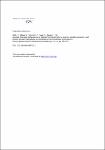Gaussia princeps luciferase (Gluc) as reporter for transcriptional activity, protein secretion and protein-protein interactions in Salmonella enterica serovar Typhimurium
Wille, Thorsten
Blank, Kathrin
Schmidt, Christiane
Vogt, Vivien
Gerlach, Roman
Gaussia princeps luciferase (Gluc) is widely used as a reporter in eukaryotes, but data about its applicability in bacteria is very limited. Here we show that a codon-optimized Gluc gene can be efficiently expressed in Salmonella enterica sv. Typhimurium (S. Typhimurium). To test different Gluc variants as transcriptional reporters, we used the siiA promoter of Salmonella Pathogenicity Island (SPI)-4 driving expression of either episomal or chromosomally integrated Gluc. Most reliable results were obtained from lysates of single-copy Gluc reporter strains. Given the small size, high activity and co-factor independence of Gluc, it might be especially suited to monitor secretion of bacterial proteins. We demonstrate its usefulness by luminescence detection of fusion proteins of Gluc and C-terminal portions of the SPI-4-encoded, type I-secreted adhesin SiiE in supernatants. The SiiE C-terminal moiety including immunoglobulin (Ig) domain 53 is essential and sufficient mediating type I-dependent secretion of Gluc. In eukaryotes, protein-protein interaction studies based on split Gluc protein complementation assays (PCA) could be established. We adapted these methods for use in Salmonella, demonstrating the interaction between the SPI-1-encoded effector SipA and its cognate secretion chaperone InvB. In conclusion, the versatile Gluc can be used to address a variety of biological questions, thus representing a valuable addition to the toolbox of modern molecular biology and microbiology.
No license information
Related Items
Show related Items with similar Title, Author, Creator or Subject.
-
2012-12-21ZeitschriftenartikelProtein-Protein Interaction Domains of Bacillus subtilis DivIVA Baarle, Suey van; Celik, Ilkay Nazli; Kaval, Karan Gautam; Bramkamp, Marc; Hamoen, Leendert W.; Halbedel, SvenDivIVA proteins are curvature-sensitive membrane binding proteins that recruit other proteins to the poles and the division septum. They consist of a conserved N-terminal lipid binding domain fused to a less conserved ...
-
2013-03-11ZeitschriftenartikelTowards further reduction and replacement of animal bioassays in prion research by cell and protein misfolding cyclic amplification assays Boerner, Susann; Wagenführ, Katja; Daus, Martin L.; Thomzig, Achim; Beekes, MichaelLaboratory animals have long since been used extensively in bioassays for prions in order to quantify, usually in terms of median infective doses [ID50], how infectious these pathogens are in vivo. The identification of ...
-
2013-08-08ZeitschriftenartikelCytomegalovirus Downregulates IRE1 to Repress the Unfolded Protein Response Stahl, Sebastian; Burkhart, Julia M.; Hinte, Florian; Tirosh, Boaz; Mohr, Hermine; Zahedi, René P.; Sickmann, Albert; Ruzsics, Zsolt; Budt, Matthias; Brune, WolframDuring viral infection, a massive demand for viral glycoproteins can overwhelm the capacity of the protein folding and quality control machinery, leading to an accumulation of unfolded proteins in the endoplasmic reticulum ...

